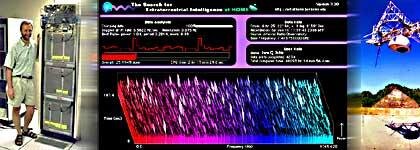- Joined
- Oct 6, 2002
- Location
- Germany NRW
Searching for intelligent life elsewhere has challenged this generation of scientists in a way previously inconceivable, requiring the processing power of the world's largest supercomputer. This priceless and vast scientific network is closer than one might naively imagine. Connecting millions of home computers to a server in Berkeley, California, has given SETI@home Project Scientist, Dan Werthimer, more than a few late nights at his listening station. Astrobiology Magazine listens to one of the world's most attentive listeners.

Cosmologists model the end of the universe as The Big Crunch-they roughly reverse the simulations of how the expansive Big Bang might have spawned all the stars and planets. But for those interested in what is happening between the bang and the crunch on those uncountable number of planets, the big crunch can mean something different. The scientists who built the world's largest supercomputer have a daily task of sorting the radio noise that showers our little corner of the galaxy. For this number crunching, their network can be as close as your own home.
No matter how much time you may think you are spending on your computer today, it is likely you are unable to overload its true capabilities. The average personal computer is running in second gear most of the time. Whatever is happening--whether surfing the internet or answering an email-- you are not likely taxing the processor (CPU cycles) or its spare bandwidth. This 'overhang' is exactly the spare capacity that innovative scientists have figured out how to tap into: what if millions of PCs could be linked together in parallel to finish a job, one that normally would require a supercomputer and its mainframe price in the hundreds of millions of dollars? The concept is called distributed computing. The most well-known implementation is a massive search of the night sky for intelligent radio signals, the SETI@home project.
intelligent radio signals
That has been one bold dream of the Berkeley team behind the SETI@home screensaver program. The project runs the world's largest virtual supercomputer. In rough terms, if the planet's total computer resources were tallied, the SETI@home volunteers contribute about one out of every thousand processing cycle potentially available everywhere. But the volunteer network is not just about crunching data. Arguably, the underlying screensaver program itself is the most widely distributed software in daily use ever conceived [1] --other than maybe web browsers-- given that the screensaver is most active when the rest of the unused programs are idle.
In a very practical way, SETI@home has changed the world's perception of what can be done while the rest of the world, and their computers, are asleep.
Top 500 Super Computers
If jumping 226 national borders isn't challenging enough, moving data back and forth to 4.7 million individual computers is something you have to be a little audacious to even dream about. Most network administrators would wilt at the assignment. For this task at Berkeley, the home server is aptly named "SAGAN", and goes well beyond handling Carl Sagan's hallmark equivalent by having powered 'billions and billions' of jobs.
As a radio astronomer, Werthimer is perhaps trained from graduate school to see the passage of time not in cyclical sunrises and sunsets-- but in his own unique data units. Werthimer's cycles are a bit different. Each day for the SETI@home network offers the equivalent to a thousand years of donated computing time. Each signal is listened to on billions of channels
The Seti Server was named "SAGAN" in memory to Dr. Carl Sagan
Working together with a radio carriage mounted above the world's largest radio telescope, Werthimer has managed to cover about ninety-five percent of the available sky from that location (Arecibo, Puerto Rico). The giant Arecibo dish spans 305 meters (more than three football fields across) in the Puerto Rican woodlands. To fill in any holes in their sky map, observations from the Southern Hemisphere are currently part of the Southern SERENDIP, a sky survey that covers stars unviewable from Arecibo. The team is also in the early planning stages with the Australian-based Parkes telescope in what is called the Southern SETI@home. [Among Parkes' many noteworthy science contributions, the telescope was the star of the Australian movie, "The Dish", since it proved the critical link that brought to the world the live images from the first moonwalk of Neil Armstrong. Without Parkes, one of the most stunning events of the century would have been just fuzzy TV static].
Southern SERENDIP
Parkes Telescope in Australien
that is a very good Article, dont miss this.
Full Story
Sir Ulli